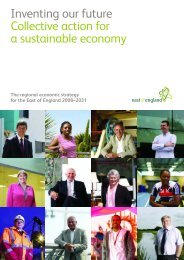Core Strategy Preferred Options document - Amazon Web Services
Core Strategy Preferred Options document - Amazon Web Services
Core Strategy Preferred Options document - Amazon Web Services
You also want an ePaper? Increase the reach of your titles
YUMPU automatically turns print PDFs into web optimized ePapers that Google loves.
Strategies, Activities and Actions – The Green Belt<br />
Over 12,700 hectares<br />
of Rochford District is<br />
designated as<br />
Metropolitan Green<br />
Belt.<br />
‘Green Belt’ is a<br />
planning designation,<br />
not a description of<br />
land. Land can be<br />
brownfield, i.e. it has<br />
been developed in the<br />
past, but is still part of<br />
the Metropolitan Green<br />
Belt.<br />
Previous community<br />
involvement has<br />
established that local<br />
people are, in the<br />
main, opposed to the<br />
release of Green Belt<br />
land for development.<br />
However, in general<br />
people are also<br />
opposed to additional<br />
development within the<br />
established<br />
settlements.<br />
Previous community involvement exercises have made it clear to us that<br />
the District’s residents consider the protection of the Green Belt to be<br />
very important. We acknowledge this and will seek to minimise the<br />
amount of Green Belt land released by prioritising land outside of the<br />
Green Belt for development, and, where Green Belt release is<br />
unavoidable, ensuring that developments occur at a reasonably high<br />
density to limit the amount of Green Belt land developed.<br />
The term ‘Green Belt’ refers to a planning designation and is not<br />
necessarily a description of the land. Land designated as Green Belt can<br />
include, primarily for historical reasons, developed land and brownfield<br />
sites. As such, whilst it is considered that all land currently designated as<br />
Green Belt helps achieve the five Green Belt purposes as set out in<br />
PPG2 to at least a degree, some Green Belt land is more worthy of<br />
protection than others. We will examine the degree to which current<br />
Green Belt land is helping to achieve the purposes of the Green Belt<br />
when considering reallocating the land.<br />
We consider that there are a number of strategic buffers that are<br />
particularly worthy of mention as they play a key role in preventing the<br />
coalescence of settlements and thus help preserve the identity of the<br />
District’s towns and villages.<br />
GB1 Green Belt Protection – <strong>Preferred</strong> Option<br />
We will seek to direct development away from the Green Belt,<br />
minimise the reallocation of Green Belt land and will prioritise the<br />
protection of Green Belt land based on how well the land helps<br />
achieve the purposes of the Green Belt.<br />
The need to prevent the coalescence of individual settlements, in<br />
order to help preserve their identities, will be given particular<br />
consideration.<br />
Rural Diversification, Green Tourism and Recreational<br />
Uses<br />
Whilst the District is predominantly Green Belt, only 3% of its VAT<br />
registered businesses are agricultural – less than the regional and<br />
national averages. It is recognised that diversification into other forms of<br />
economic activity is necessary if farms are to remain viable. There is<br />
concern that our current restrictive approach to the Green Belt will not<br />
allow the District to achieve its vision of green tourism developing in the<br />
District and may hinder rural diversification. However, any over<br />
relaxation of Green Belt policies would be harmful to the character of the<br />
Green Belt, undermine the purposes of including land within it, and be<br />
contrary to sustainability objectives. A balance needs to be struck.<br />
42
















